Summary of the Evaluation of the
TypeMatrix Ergonomic Keyboard
 Click here for a printable (pdf) version of the full study
Click here for a printable (pdf) version of the full study
 Click here to view the full study (below the summary)
Click here to view the full study (below the summary)
Study Results
- 94% of women with RSI pain reported significant lessening of pain
after 5 weeks
- 75% of men with RSI pain reported significant lessening of pain
after 5 weeks
- 95% of all participants in the study chose to continue to use the
TypeMatrix after the completion of the study
- Women reached their prior typing speed and accuracy in
8 to 17 days of use
- Men reached their prior typing speed and accuracy in
8 to 24 days of use
- Many participants reported increased speed, accuracy and efficiency once the initial adjustment with the keyboard was made
The following wrist, forearm and shoulder positions were reduced to more optimally neutral postures:
- Forearm pronation
- Ulnar deviation
- Shoulder rotation
- Wrist extension
Noticeable positive outcomes:
- Greater balance of motions of all fingers and both hands
- Neutral postures of arms, hands and shoulders were maintained
- Neutral body posture maintained, centered on the monitor
Full Evaluation of the
TypeMatrix Ergonomic Keyboard
 Click here for a printable (pdf) version of this document
Click here for a printable (pdf) version of this document
Introduction
Over the past several decades in the office environment,
Repetitive Strain Injury (RSI) has been attributed to
computer keyboard and mouse usage. Several reasons have
been cited:
- physical design of the keyboard,
- location of the keyboard and its relationship to
the mouse, as well as
- static, awkward and fatiguing postures of the
worker.
The purpose of this study was two fold:
- first, to determine if a neutral posture
could be more easily maintained using the TypeMatrix
keyboard ( Qwerty layout), and
- secondly, for those participants who complained
of forearm/wrist/hand pain tingling/numbness, to determine
if there was a lessening of symptoms after using this
alternatively designed keyboard.
The Study
Typing: an Overview
Keyboarding is a complex process dependent upon the
variables of different typists: their skills, the keyboard
they use, and their physical "ergonomic" setup, to say
nothing of their physiological makeup. Attempts are made
to control these variables, and this involves a well thought
out balance between the following:
- Tension (job related) and relaxation
(exercise);
- Eliminating unnecessary finger movements;
- Using the shortest, most direct motion paths to
the next key;
- Decreasing the amount of force (effort) to strike
keys;
- Decreasing the number of starts and stops as speed
increases;
- Establishing neutral postures at the
workstation.
The stroking or keying motion is not an isolated motion;
it requires an interval of time between two successive strokes.
The time factor is set by the typist. The keyboard, on
the other hand, sets the interval of time between the
release of one key and the engagement of the next. The
rhythm of the typist and the keyboard must be in sync,
otherwise the typist will fatigue. This is why we often
hear from good typists that they prefer one keyboard over
another. The specific keyboard used also changes the tactile
response that the operator feels. Some call this a personal
preference. I believe it is a compatibility issue between
the worker and the machine, in this case the typist and the
keyboard.
The critical point in key stroking is the unfelt force
as the finger strikes the key. Almost all motion disappears
when the finger releases the key. The very nature of key
stroking is an orderly continuous process depending upon
the short time interval required by the keyboard and the
longer one required by the typist.
The task of studying typing behavior and evaluating keyboard
efficiency has been done by many researchers in the past. The
early engineers and designers had the motivation to search
for the optimal arrangements of letters and numbers on the
keyboard. Yet, until recently, few have considered the
removal of the staggered column layout found on the standard
keyboard, a design inherited from the original mechanical
typewriter. The TypeMatrix keyboard has accomplished this
with the ortho-linear (matrix) design.
I applied the following principles when comparing the
TypeMatrix keyboard to the keyboards used by the participants
prior to start of this study:
- Simple motion patterns and simple processes by the
user are easier to master than complicated ones;
- Simple motion patterns and simple processes are easier
to execute than complicated ones;
- Short movements expend less energy than long ones;
- Unnecessary motions create fatigue;
- Rhythmic motion patterns and sequences are less fatiguing
than uneven ones.
Split vs. Fan Keyboard
Current literature and keyboard manufacturers describe
keyboards that pivot around one point, whether fixed or
variable, as "split" keyboards. In my opinion these boards
are similar to oriental hand fans and should not be called
split boards but rather fan boards. A split board either
physically breaks into several pieces, or the alphanumeric
portions of the keyboard are separated in the keyboard
layout.
The keyboard design types that were in use by the
participants prior to the study were:
- Conventional flat keyboard
- Fixed angle fan board
- Adjustable angle fan board
The open angle of the fixed fan keyboard was typically
25 degrees and the adjustable angle fan board ranged from
14 degrees to 30 degrees. Slope angles ranged from 0
degrees to 15 degrees. All the keyboards had the QWERTY
layout of keys.
Observable wrist and forearm postures of participants
when using the three designs included:
- Pronation of forearms
- Ulnar deviation of wrists
- Unbalanced motion of fingers
- Extension of wrists
Note: The wrists came closer to a neutral posture as
the opening angle of the adjustable fan boards increased.
However, there was noticeable rotation of elbows and
shoulders when fan boards were used.
Eliminating issues with the following
accommodations:
- Participants' work stations adjusted
according to the criteria specified for video display
terminals as per the American National Standard for
Human Factors Engineering of Video Display Terminal Work
Stations (ANSI-HFS-100-1988) (see profiles). The height
of the keyboard tray was adjusted so that participants'
forearms and wrists were parallel to the floor, and
their elbow angles were approximately 90 degrees - 95
degrees. The height of the monitor was adjusted so that
eye declination angle to the middle of the screen was 30
degrees. Also, bifocal, trifocal and progressive lens
users had the height of their monitors properly adjusted
to eliminate neck extension and flexion. Chairs were
adjusted for height and support of the natural lordotic
curves of their spines. Footrests, new chairs, wrist
rests, Vu Rysers and retractable keyboard/mouse trays
were provided as needed to establish neutral
non-fatiguing postures. The TypeMatrix alternative
keyboard was provided and used in the comparative study.
- Provided a Stretch-It Exercise program
- Provided nursery rhymes to be typed in a relaxed
environment
- Provided an ergonomically designed alternative
keyboard (TypeMatrix) for comparison to the current
keyboard being used.
Accommodations one, two and three were done consistently
so that the only variable of concern would be the keyboard
being used.
Evaluation Procedure (Instructions given to
participants)
Using your keyboard and the TypeMatrix alternative
keyboard, please type the attached nursery rhymes as
follows:
- Type on each keyboard for six 20-minute sessions
with a 5-minute break between sessions, the first two being
practice sessions.
- Enter text as quickly and efficiently as possible.
- Do not correct any errors made.
- Print out each session.
- Immediately following the last text entry (session 6)
for each keyboard, answer the question on the questionnaire
provided.
- Attach the printouts to the appropriate keyboard
questionnaire.
- Submit your printouts (12) and two questionnaires in the
self-addressed envelope provided.
Conclusion
When using the TypeMatrix keyboard the following wrist,
forearm and shoulder postures were observed:
- Minimal to no forearm pronation
- Minimal to no ulnar deviation
- Minimal to no shoulder or elbow rotation
- Minimal to no wrist extension
- Balanced motion of fingers
...due to the unique design features of:
- The enter and back space functions being large keys
and in the center of keyboard, thus utilizing the stronger
index fingers and eliminating the stressing and reaching of
the weaker smaller digits,
- The split keyboard layout which places the hands and
shoulders into a neutral position without elongating the
keyboard,
- The smaller footprint of the keyboard which allows the
keyboard and user to be easily centered in front of the
monitor; it also eliminates shoulder rotation and abduction,
as well as ulnar deviation of the wrist when using the
numeric keypad and mouse,
- The ortho-linear (matrix) key arrangement of the columns
which allows the fingers to stretch a consistent minimum
distance when traveling to keys above and below the home
row,
Repetitive Strain Injury (RSI) symptoms
- Of the 26 female and 17 male participants, 16
females and 8 males reported symptoms of RSI at the
beginning of the study.
- Of these, 15 females (94%) and 6 males (75%) reported
significantly lessened pain and symptoms after 5 weeks.
- After six months since the survey began, 41 out of 43
participants (95%) are still using the TypeMatrix keyboard
with excellent results.
In my opinion, these results, and others not mentioned
here but noted in the study itself, indicate that the
TypeMatrix keyboard is a much more ergonomic keyboard than
the types of keyboards previously used by the participants
of this study. The advantages include:
- reduction or elimination of the positions and
motions known to cause injury,
- an acceptable adaptation time interval, and
- the possibility for greater typing efficiency (as
measured by speed and accuracy).


Raymond P. Bello, MS, CDE, CIE
BEST Associates, Injury Management & Prevention Services
Executive Director
|

